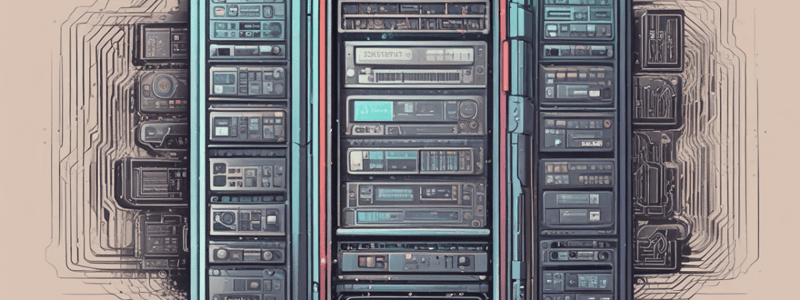Podcast
Questions and Answers
What is the primary goal of caching?
What is the primary goal of caching?
To reduce latency and improve response times, decrease the load on the primary data source, and improve overall performance and scalability of applications.
What type of caching is typically used to store frequently accessed database query results?
What type of caching is typically used to store frequently accessed database query results?
Database caching
What is the main difference between client-side caching and server-side caching?
What is the main difference between client-side caching and server-side caching?
Client-side caching is stored on the client (e.g., web browser), while server-side caching is stored on the server.
What is the purpose of a Content Delivery Network (CDN) cache?
What is the purpose of a Content Delivery Network (CDN) cache?
What is an example of a caching strategy that loads data into the cache only when requested by the application?
What is an example of a caching strategy that loads data into the cache only when requested by the application?
What is the purpose of write-through caching?
What is the purpose of write-through caching?
What is the main advantage of using a write-back cache?
What is the main advantage of using a write-back cache?
What is an example of server-side caching?
What is an example of server-side caching?
What is the primary benefit of caching in terms of application performance?
What is the primary benefit of caching in terms of application performance?
What is an example of client-side caching?
What is an example of client-side caching?
What is the main benefit of using a write-back cache?
What is the main benefit of using a write-back cache?
What is the primary advantage of a read-through cache?
What is the primary advantage of a read-through cache?
What is the purpose of a cache eviction policy?
What is the purpose of a cache eviction policy?
What is the first step in implementing effective caching?
What is the first step in implementing effective caching?
Why is it essential to implement cache invalidation strategies?
Why is it essential to implement cache invalidation strategies?
What is the primary advantage of distributed caching?
What is the primary advantage of distributed caching?
How can database indexing optimize caching?
How can database indexing optimize caching?
What is the purpose of hybrid caching architectures?
What is the purpose of hybrid caching architectures?
How do e-commerce websites typically use caching?
How do e-commerce websites typically use caching?
What is the ultimate goal of implementing caching in system design?
What is the ultimate goal of implementing caching in system design?
Flashcards are hidden until you start studying
Study Notes
Caching Definition and Purpose
- Caching is the process of storing copies of data in a temporary storage location to reduce the time it takes to access this data.
- The primary goals of caching are to:
- Reduce latency and improve response times.
- Decrease the load on the primary data source.
- Improve the overall performance and scalability of applications.
Types of Caching
- Client-Side Caching:
- Stored on the client, such as in a web browser’s cache.
- Reduces the need to fetch resources from the server repeatedly.
- Examples: browser cache, mobile app cache.
- Server-Side Caching:
- Stored on the server to speed up data retrieval for client requests.
- Reduces database load and accelerates dynamic content delivery.
- Examples: Redis, Memcached.
- Database Caching:
- Stores frequently accessed database query results.
- Improves database read performance and reduces query processing time.
- Examples: database query cache, in-memory database.
- Content Delivery Network (CDN) Caching:
- Distributes copies of static content to edge servers around the world.
- Reduces latency by serving content from the nearest edge server to the user.
- Examples: Cloudflare, Akamai.
Caching Strategies
- Cache-Aside (Lazy Loading):
- Data is loaded into the cache only when requested by the application.
- If the data is not in the cache (cache miss), it is fetched from the data source and then stored in the cache for future use.
- Example: A web application querying a database only when a cache miss occurs.
- Write-Through Cache:
- Data is written to both the cache and the primary data source simultaneously.
- Ensures data consistency between the cache and the data source.
- Example: Updating a product inventory count in both the cache and the database at the same time.
- Write-Back (Write-Behind) Cache:
- Data is written to the cache initially, with changes propagated to the data source asynchronously.
- Improves write performance but risks data loss if the cache fails before the write is propagated.
- Example: Logging user actions to a cache, with periodic updates to the database.
- Read-Through Cache:
- The application interacts only with the cache, which retrieves data from the data source if it is not present in the cache.
- Simplifies application logic by centralizing data access through the cache.
- Example: A caching layer intercepting all read requests and fetching from the database on cache misses.
- Cache Eviction Policies:
- Determine how data is removed from the cache when it reaches its capacity.
- Common policies include:
- Least Recently Used (LRU): Removes the least recently accessed items first.
- First In, First Out (FIFO): Removes the oldest items first.
- Least Frequently Used (LFU): Removes the least frequently accessed items first.
Best Practices for Caching
- Determine What to Cache:
- Identify frequently accessed data that is expensive to retrieve or compute.
- Examples: User session data, product details, query results.
- Set Appropriate TTL (Time-To-Live):
- Define expiration times for cached data to ensure it stays fresh.
- Avoids serving stale data and balances cache performance with data accuracy.
- Cache Invalidation:
- Implement strategies to invalidate or update cached data when the underlying data changes.
- Examples: Cache invalidation on data update events, scheduled cache refreshes.
- Monitor Cache Performance:
- Track cache hit rates, miss rates, and latency to evaluate caching effectiveness.
- Adjust cache configurations and strategies based on monitoring data.
- Handle Cache Failures Gracefully:
- Ensure the application can continue functioning correctly if the cache is unavailable.
- Implement fallback mechanisms to fetch data directly from the primary data source.
Advanced Caching Techniques
- Distributed Caching:
- Use a distributed cache to store data across multiple nodes for horizontal scalability.
- Ensures high availability and fault tolerance by replicating data.
- Examples: Redis Cluster, Amazon ElastiCache.
- Application-Level Caching:
- Implement caching within the application logic to store computational results or frequently used data structures.
- Examples: Local in-memory caches, application-specific caching frameworks.
- Database Indexing:
- Use database indexes to speed up query processing and reduce the need for caching.
- Balances the benefits of caching with optimized data retrieval techniques.
- Hybrid Caching Architectures:
- Combine multiple caching strategies to optimize performance.
- Examples: Using both CDN caching for static content and server-side caching for dynamic content.
Real-World Examples
- E-commerce Websites:
- Cache product details, user sessions, and shopping carts to improve page load times and handle high traffic during sales events.
- Use CDNs to serve static content like images and scripts.
- Social Media Platforms:
- Cache user profiles, feeds, and media content to enhance user experience and reduce backend load.
- Implement distributed caching to manage large volumes of data and traffic.
- News Websites:
- Cache frequently accessed articles, headlines, and metadata to ensure fast content delivery.
- Use write-through caching for real-time updates and consistency.
Studying That Suits You
Use AI to generate personalized quizzes and flashcards to suit your learning preferences.





